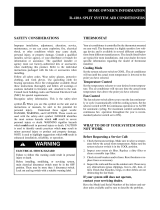
Page 11 of 11506318-03P Issue 1850
Important System Information
• Your system should never be operated without a clean
air lter properly installed.
• Return air and supply air registers should be free from
restrictions or obstructions to allow full ow of air.
Regular Maintenance Requirements
Your system should be regularly inspected by a qualied
service technician. These regular visits may include
(among other things) checks for:
• Motor operation
• Ductwork air leaks
• Coil & drain pan cleanliness (indoor & outdoor)
• Electrical component operation & wiring check
• Proper refrigerant level & refrigerant leaks
• Proper airow
• Drainage of condensate
• Air lter(s) performance
• Blower wheel alignment, balance & cleaning
• Primary & secondary drain line cleanliness
• Proper defrost operation (heat pumps)
There is some routine maintenance procedures you can do
to help keep your system operating at peak performance
between visits.
Air Filter
Inspect air lters at least monthly and replace or clean as
required. Disposable lters should be replaced. Washable
lters may be cleaned by soaking in mild detergent and
rinsing with cold water. Replace lters with the arrows
pointing in the direction of airow. Dirty lters are the most
common cause of poor heating / cooling performance and
compressor failures.
Indoor Coil
If the system has been operated with a clean lter in place,
it should require minimal cleaning. Use a vacuum cleaner
and soft brush attachment to remove any accumulation of
dust from the top and underside of the nned coil surface.
However, perform this maintenance only when the coil is
completely dry.
If the coil cannot be cleaned by this method, call your
dealer for service. It may need a detergent solution and
rinsing with water for cleaning, which may require coil
removal. You should not attempt this yourself.
Condensate Drain
During cooling season check at least monthly for free ow
of drainage and clean if necessary.
Condenser Coils
Grass cuttings, leaves, dirt, dust, lint from clothes dryers,
and fall off from trees can be drawn into coils by movement
of the air. Clogged condenser coils will lower the efciency
of your unit and could cause damage to the condenser.
Periodically, debris should be brushed from the condenser
coils.
SHARP OBJECT HAZARD!
Condenser coils have sharp edges. Wear adequate
body protection on body extremities (e.g. gloves).
FAILURE TO FOLLOW THIS WARNING COULD
RESULT IN BODILY INJURY.
WARNING
Use a soft bristle brush with light pressure only. DO NOT
damage or bend condenser coil ns. Damaged or bent ns
may affect unit operation.
Painted Surfaces
For maximum protection of the unit’s nish, a good grade
of automobile wax should be applied every year. In
geographical areas where water has a high concentration
of minerals (calcium, iron, sulfur, etc.). It is recommended
that lawn sprinklers not be allowed to spray the unit. In
such applications, the sprinklers should be directed away
from the unit. Failure to follow this precaution may result
in premature deterioration of the unit nish and metal
components.
In sea coast areas, special maintenance is required due
to the corrosive atmosphere provided by the high salt
concentration in ocean mists and the air. Periodic washing
of all exposed surfaces and coil will add additional life to
your unit. Please consult your installing dealer for proper
procedures in your geographic area.
IF YOUR SYSTEM DOES NOT WORK, BEFORE
REQUESTING A SERVICE CALL:
1. Ensure thermostat is set below (cooling) or above
(heating) room temperature and that the system lever
is in the “COOL”, “HEAT” or “AUTO” position.
2. Inspect your return air lter: If it is dirty your air
conditioner may not function properly.
3. Check indoor and outdoor disconnect switches.
Conrm circuit breakers are ON or that fuses have not
blown. Reset breakers/replace fuses as necessary.
4. Inspect the outdoor unit for clogged condenser coils,
(grass cuttings, leaves, dirt, dust or lint). Ensure that
branches, twigs or other debris are not obstructing the
condenser fan.
IF YOUR SYSTEM STILL DOES NOT OPERATE,
CONTACT YOU SERVICING DEALER.
Be sure to describe the problem, and have the model and
serial numbers of the equipment available.
If warranted replacements parts are required, the warranty
must be processed through a qualied distribution location.











